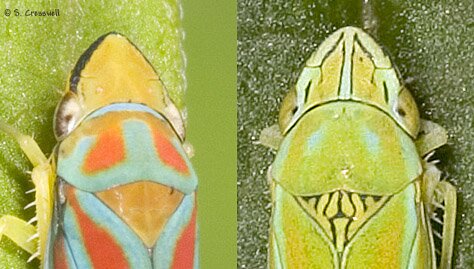
This genus page is designed to help differentiate the two most common Graphocephala species found in West Virginia. Shown at above left is the head of Graphocephala coccinea, which is essentially unmarked on top. Note that the scutellum and metanotum are also unmarked. At above right is the head of Graphocephala versuta, which is marked with thin black lines, as are the scutellum and metanotum. Also note the pale blue area outlining the head in Graphocephala versuta, which G. coccinea lacks. These are the key traits; don't be misled by other factors such as color, which may vary widely from individual to individual within the same species.
Another key difference between these two common species is shown in the image below. A number of Graphocephala species have small black triangles at the rear of the forewings. In Graphocephala versuta, shown at below right, these "teeth" are more numerous and sharply angled. G. coccinea is shown at below left for comparison.

Another species to watch for in West Virginia, not pictured on this site, is Graphocephala fennahi, which is distinguished from G. coccinea and G. versuta in several ways. One is length. Graphocephala fennahi is longer, measuring 7-9 mm while the other two species are usually 5.0-6.5 mm. Another way to identify G. fennahi is by the host plant, which is Rhododendrons only. The other two species feed on a variety of plants, though G. coccinea has a special fondness for Blackberry and Raspberry plants. Also note that on G. fennahi the red stripes tend to be narrow, especially the top one, which may be much smaller in size than in the other two species mentioned here.
On to the other pages:


